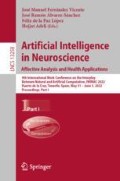Abstract
Analyzing brain structures in the medical imaging field poses challenging problems due to neurological diseases’ heterogeneity. Besides, measuring brain changes quantitatively in neurodevelopmental is crucial to evaluate clinical outcomes correctly. From a computer-vision perspective, establishing correspondences between shapes often requires computing similarity measures that, in most cases, are unavailable. This paper proposes an unsupervised probabilistic framework for shape correspondence analysis on brain structures by using variational unsupervised learning. The probabilistic framework comprehensively captures the form of brain shapes from surface descriptors. Then, we learned clustered latent space representations of surface descriptors by using mixtures distributions for Gaussian process latent variable models to avoid computing similarity measures, which classify the resulting latent vectors to establish group-wise correspondences. The experimental results show how the proposed model captures non-linearities in non-rigid 3D shapes even when they present occlusion or partialities. These results demonstrated that the proposed model is suitable for shape correspondence analysis.
Access this chapter
Tax calculation will be finalised at checkout
Purchases are for personal use only
Notes
- 1.
Real correspondence label in both shapes.
- 2.
Different levels of geodesic error in which it is evaluated what percentage of matches are located on it.
References
Aflalo, Y., Dubrovina, A., Kimmel., R.: Spectral generalized multidimensional scaling. Int. J. Comput. Vis. 118(3), 380–392 (2016)
Boscaini, D., Masci, J., Rodolá, E., Bronstein, M.M.: Learning shape correspondence with anisotropic convolutional neural networks. arXiv, Cornell University (2016)
Bronstein, A.M., Bronstein, M.M., Kimmel, R.: Calculus of nonrigid surfaces for geometry and texture manipulation. IEEE Trans. Vis. Comput. Graph 13(5), 902–913 (2007)
Bronstein, M.M., Kokkinos, I.: Scale-invariant heat kernel signatures for non-rigid shape recognition. In: Proceedings of CVPR, pp. 1704–1711 (2010)
Chouvatut, V., Boonchieng, E.: Brain tumor’s approximate correspondence and area with interior holes filled. In: 2017 14th International Joint Conference on Computer Science and Software Engineering (JCSSE), pp. 1–5 (2017)
Cosmo, L., Rodolá, E., Bronstein, M.M., Torsello, A., Cremers, D., Sahillioglu, Y.: Shrec’16: Partial matching of deformable shapes. In: Eurographics Workshop on 3D Object Retrieval (2016)
Damianou, A.C., Titsias, M.K., Lawrence, N.D.: Variational inference for latent variables and uncertain inputs in gaussian processes. J. Mach. Learn. Res. (2016)
Gousias, I.S., et al.: Magnetic resonance imaging of the newborn brain: manual segmentation of labelled atlases in term-born and preterm infants. NeuroImage 62(3), 1499–1509 (2012)
Katayama, Y., Oshima, H., Kano, T., Kobayashi, K., Fukaya, C., Yamamoto, T.: Direct effect of subthalamic nucleus stimulation on levodopa-induced peak-dose dyskinesia in patients with parkinson’s disease. Stereotact. Funct. Neurosurg. 84, 176–179 (2006)
Kezurer, I., Kovalsky, S.Z., Basri, R., Lipman, Y.: Tight relaxation of quadratic matching. In: Computer Graphics Forum, vol. 34(5), 115–128 (2015)
Kim, V.G., Lipman, Y., Funkhouser, T.A.: Blended intrinsic maps. TOG 30(4), 1–12 (2011)
Lahner, Z., et al.: Efficient deformable shape correspondence via kernel matching. arXiv, Cornell University (2017)
Legaz-Aparicio, A.-G., et al.: Efficient variational approach to multimodal registration of anatomical and functional intra-patient tumorous brain data. Int. J. Neural Syst. 27(6), 1750014 (2017)
Liang, L., Szymczak, A., Mingqiang, W.: Geodesic spin contour for partial near-isometric matching. Comput. Graph. 146, 156–171 (2015)
Ovsjanikov, M., Ben-Chen, M., Solomon, J., Butscher, A., Guibas., L.: Functional maps: a flexible representation of maps between shapes. ACM Trans. Graph. 31(4), 1–11 (2012)
Rodolá, E., Buló, S.R., Windheuser, T., Vestner, M., Cremers., D.: Dense non-rigid shape correspondence using random forests. In: Proceedings of the 2014 IEEE Conference on Computer Vision and Pattern Recognition, CVPR 2014, pp. 4177–4184 (2014)
Talo, M., Yildirim, O., Baloglu, U.B., Aydin, G., Acharya, U.R.: Convolutional neural networks for multi-class brain disease detection using MRI images. Comput. Med. Imaging Graph. 78, 101673 (2019)
Vestner, M., et al.: Efficient deformable shape correspondence via kernel matching. In: 2017 International Conference on 3D Vision (3DV), pp. 517–526 (2017)
Sahillioglu, Y., Yemez, Y.: Coarse-to-fine combinatorial matching for dense isometric shape correspondence. Comput. Graph. Forum 30(5), 1461–1470 (2011)
Acknowledgements
This research was developed under the project: “DESARROLLO DE UN SISTEMA AUTOMÁTICO DE ANÁLISIS DE VOLUMETRÍA CEREBRAL COMO APOYO EN LA EVALUACIÓN CLÍNICA DE RECIÉN NACIDOS CON ASFIXIA PERINATAL” financed by MINCIENCIAS with code COL497984467090.
Author information
Authors and Affiliations
Corresponding author
Editor information
Editors and Affiliations
Rights and permissions
Copyright information
© 2022 Springer Nature Switzerland AG
About this paper
Cite this paper
Minoli, J.P.V., Orozco, Á.A., Porras-Hurtado, G.L., García, H.F. (2022). Brain Shape Correspondence Analysis Using Variational Mixtures for Gaussian Process Latent Variable Models. In: Ferrández Vicente, J.M., Álvarez-Sánchez, J.R., de la Paz López, F., Adeli, H. (eds) Artificial Intelligence in Neuroscience: Affective Analysis and Health Applications. IWINAC 2022. Lecture Notes in Computer Science, vol 13258. Springer, Cham. https://doi.org/10.1007/978-3-031-06242-1_54
Download citation
DOI: https://doi.org/10.1007/978-3-031-06242-1_54
Published:
Publisher Name: Springer, Cham
Print ISBN: 978-3-031-06241-4
Online ISBN: 978-3-031-06242-1
eBook Packages: Computer ScienceComputer Science (R0)

